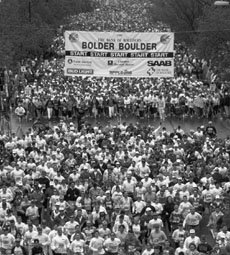Areas of Simulation Application
| Simulation is one of the most useful of all management science techniques. The reason for this popularity is that simulation can be applied to a number of problems that are too difficult to model and solve analytically. Some analysts feel that complex systems should be studied via simulation whether or not they can be analyzed analytically because simulation provides such an easy vehicle for experimenting on the system. As a result, simulation has been applied to a wide range of problems. Surveys conducted during the 1990s indicated that a large majority of major corporations use simulation in such functional areas as production, corporate planning, engineering, financial analysis, research and development, marketing, information systems, and personnel. Following are descriptions of some of the most common applications of simulation. QueuingA major application of simulation has been in the analysis of queuing systems. As indicated in Chapter 13, the assumptions required to solve the operating characteristic formulas are relatively restrictive . For the more complex queuing systems (which result from a relaxation of these assumptions), it is not possible to develop analytical formulas, and simulation is often the only available means of analysis. Inventory ControlMost people are aware that product demand is an essential component in determining the amount of inventory a commercial enterprise should keep. Most of the mathematical formulas used to analyze inventory systems make the assumption that this demand is certain (i.e., not a random variable). In practice, however, demand is rarely known with certainty . Simulation is one of the few means for analyzing inventory systems in which demand is a random variable, reflecting demand uncertainty. Inventory control is discussed in Chapter 16. Production and ManufacturingSimulation is often applied to production problems, such as production scheduling, production sequencing, assembly line balancing (of work-in-process inventory), plant layout, and plant location analysis. It is surprising how often various production processes can be viewed as queuing systems that can only be analyzed using simulation. Because machine breakdowns typically occur according to some probability distributions, maintenance problems are also frequently analyzed using simulation. FinanceCapital budgeting problems require estimates of cash flows, which are often a result of many random variables. Simulation has been used to generate values of the various contributing factors to derive estimates of cash flows. Simulation has also been used to determine the inputs into rate of return calculations in which the inputs are random variables , such as market size , selling price, growth rate, and market share. MarketingMarketing problems typically include numerous random variables, such as market size and type, and consumer preferences. Simulation can be used to ascertain how a particular market might react to the introduction of a product or to an advertising campaign for an existing product. Another area in marketing where simulation is applied is the analysis of distribution channels to determine the most efficient distribution system. Public Service OperationsThe operations of police departments, fire departments, post offices, hospitals , court systems, airports, and other public systems have all been analyzed by using simulation. Typically, such operations are so complex and contain so many random variables that no technique except simulation can be employed for analysis. Environmental and Resource AnalysisSome of the more recent innovative applications of simulation have been directed at problems in the environment. Simulation models have been developed to ascertain the impact on the environment of projects such as nuclear power plants, reservoirs, highways, and dams. In many cases, these models include measures to analyze the financial feasibility of such projects. Other models have been developed to simulate pollution conditions. In the area of resource analysis, numerous models have been developed in recent years to simulate energy systems and the feasibility of alternative energy sources.
|
EAN: 2147483647
Pages: 358
